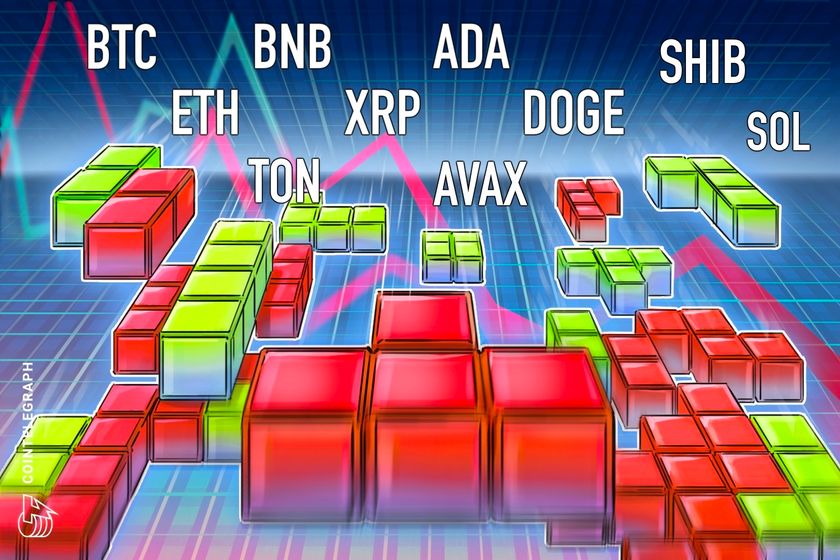
Payments firm Ripple has inked a new partnership with the Tokyo-based arm of HashKey Group in an effort to bring XRP Ledger-based supply chain finance solutions to Japan. Ripple and HashKey DX, a Japanese consulting company of the HashKey Group, will also work with Japanese financial services giant SBI Holdings, which has been partnered with […]
The post Ripple Forms Partnership With Tokyo Unit of $1,200,000,000 Firm To Push for XRPL-Powered Solutions in Japan appeared first on The Daily Hodl.

Bitcoin’s drop to $56,500 crushed bullish traders’ sentiment and took a heavy toll on altcoin prices but are generational buying opportunities emerging?
Bitcoin (BTC) sliced through the $60,000 support on May 1, signaling that the uptrend has weakened. While the fall has muddied the short-term picture for Bitcoin, the analysts remain bullish for the long term.
Traders latch on to every bit of negative news when the price action turns bearish. Investor sentiment received a beating on the muted response to the Hong Kong spot Bitcoin and Ether (ETH) exchange-traded funds (ETFs) that debuted on April 30. Continued outflows from the United States-based spot Bitcoin ETFs for the fifth consecutive day also did little to soothe nerves.
Every bull phase witnesses sharp corrections, which shake out the weak hands. The lower levels give an opportunity to the long-term investors to add to their portfolios. However, it is better to wait for the price to confirm a bottom before initiating large bets.
 Ripple has teamed up with Tokyo-based consulting firm Hashkey DX to bring XRP Ledger (XRPL) blockchain solutions to the Japanese market, aiming to revolutionize enterprise blockchain use cases in Japan, primarily through supply chain solutions. This strategic partnership will leverage Hashkey DX’s expertise to develop and implement these solutions, in collaboration with SBI Ripple Asia—a […]
Ripple has teamed up with Tokyo-based consulting firm Hashkey DX to bring XRP Ledger (XRPL) blockchain solutions to the Japanese market, aiming to revolutionize enterprise blockchain use cases in Japan, primarily through supply chain solutions. This strategic partnership will leverage Hashkey DX’s expertise to develop and implement these solutions, in collaboration with SBI Ripple Asia—a […]

Ripple has partnered with HashKey DX to introduce XRP Ledger-based blockchain solutions to the Japanese market.
SBI Group will become the first Japanese corporation to use XRP Ledger (XRPL) blockchain supply chain solutions as Ripple looks to drive enterprise blockchain solution use cases in Japan.
SBI will break new ground in Japan after Ripple announced it has entered a strategic partnership with Tokyo-based consulting firm HashKey DX. The latter is set to introduce XRPL enterprise solutions to the Japanese market.
HashKey will collaborate with Ripple and SBI Ripple Asia, a joint venture between SBI Holdings and Ripple, to build and introduce supply chain finance solutions in the country. The tools will be built on the XRPL, the decentralized blockchain network initially developed by Ripple Labs.

Bitcoin and altcoins could be en route to retest their recent strong support levels as bears try to extend the correction.
Bitcoin (BTC) continues to trade inside a large range, suggesting indecision about the next trending move. Analysts trying to predict the direction are enthused by the $1.3 billion of USD Coin (USDC) transferred to Coinbase by whale addresses. Expectations are that the funds will be used to buy Bitcoin and Ether (ETH).
Large investors are not only buying the top two coins by market capitalization. CoinShares head of research James Butterfill said in a recent report based on a survey of 64 institutional investors that 15% of the respondents had invested in Solana (SOL). In comparison, none of the investors held Solana in the firm’s January survey.
Morgan Creek Capital CEO Mark Yusko said in a recent interview with The Wolf Of All Streets podcast that about $300 billion of baby boomers’ wealth is likely to enter into digital assets within 12 months. This inflow could boost the cryptocurrency market capitalization to $6 trillion.

Ripple has fired back against the U.S. Securities and Exchange Commission’s (SEC) request for it to pay nearly $2 billion in penalties. In March, the SEC asked the court to order Ripple to pay $876,308,712 in disgorgement, $198,150,940 in prejudgment interest, and a $876,308,712 civil penalty, which totals around $1.95 billion. Ripple filed an opposition […]
The post Ripple Rejects SEC’s $2,000,000,000 Request for Penalties, Says Firm Will Pay No More Than $10,000,000 appeared first on The Daily Hodl.
 Ripple Labs has filed its opposition to the request by the U.S. Securities and Exchange Commission (SEC) for the company to pay $2 billion in fines in the XRP case. “The SEC’s draconian remedial requests are ungrounded in law or principle. This court should reject them in their entirety,” Ripple stated. Ripple Files Opposition to […]
Ripple Labs has filed its opposition to the request by the U.S. Securities and Exchange Commission (SEC) for the company to pay $2 billion in fines in the XRP case. “The SEC’s draconian remedial requests are ungrounded in law or principle. This court should reject them in their entirety,” Ripple stated. Ripple Files Opposition to […]

Bitcoin and altcoins have turned bullish following the BTC supply halving. Are new all-time highs in the making?
The S&P 500 Index (SPX) fell 3.05% last week as hopes for a handful of interest rate cuts by the United States Federal Reserve dwindled due to elevated inflation readings. In comparison, Bitcoin (BTC) declined just 1.1% last week, indicating strength.
Capriole Investments founder Charles Edwards said in a X post that Bitcoin’s raw electricity cost per mined block is $77,400. He added that Bitcoin’s price remains below the “electrical cost” for only about a couple of days every four years, which means that Bitcoin is “trading at a DEEP DISCOUNT.”
Bitcoin is likely to remain volatile in the next few days as the bulls and the bears battle it out for supremacy. If Bitcoin remains range-bound in the near term, it may attract buyers toward select altcoins that may resume their up move.

Ripple’s chief legal officer (CLO) Stuart Alderoty says the payments company is taking action in response to a court filing submitted by the U.S. Securities and Exchange Commission (SEC) last month. In a Motion for Remedies and Entry of Final Judgment filed on March 25th, the SEC requested the US District Court for the Southern […]
The post Ripple To File Response to SEC’s $2,000,000,000 Penalty Request Within a Week, Says the Payments Firm’s CLO appeared first on The Daily Hodl.

Institutional investors, asset managers and banks are racing to bring financial assets on-chain in a market estimated to grow to $16 trillion in value.
Traditional finance (TradFi) firms have warmed up to the idea of tokenizing financial assets on public blockchains as the race toward blockchain-based tokenization heats up.
According to RippleX senior vice president Markus Infanger, TradFi players are finally bringing financial assets on-chain as they look to deploy for production and solve pain points in various value chains.
Speaking exclusively to Cointelegraph during Paris Blockchain Week, Infanger said that TradFi’s use of blockchain is finally becoming tangible.